Abstract
1. The direct positive chronotropic effects of angiotensin II (AII) and its degradation products angiotensin III (AIII) and angiotensin IV (AIV) were established in pithed rats and in rat spontaneously beating right atria. 2. In pithed rats, AII, AIII and AIV caused dose-dependent tachycardia with similar maximal responses (110 beats min-1). The beta-adrenoceptor antagonist propranolol (3.37 x 10(-6) mol kg-1) but not the alpha 1-adrenoceptor antagonist prazosin (2.38 x 10(-7) mol kg-1) significantly reduced these effects (P < 0.05; n = 7-8), but 20-25% of the responses could not be blocked by propranolol. 3. In isolated atria, AII, AIII and AIV caused concentration-dependent increases in beating rate with similar maximal responses to AII and AIII (34.3 +/- 0.4 and 34.7 +/- 0.4 beats min-1; n = 9-10), and a lower maximal response to AIV (26.8 +/- 0.6 beats min-1; P < 0.05; n = 8). AIII was about 9 times less potent than AII, whereas AIV proved approximately 3800 times less potent than AII. Neither propranolol (1 microM) nor prazosin (1 microM) could influence the effects of the angiotensin peptides. 4. In isolated atria, the selective AT1-receptor antagonist, losartan (10, 100 and 300 nM) caused parallel rightward shifts of the concentration-response curves for AII and AIII, whereas the selective AT2- receptor antagonist PD123177 (1 microM) did not influence the effects of AII and AIII. The aminopeptidase-A and -M inhibitor amastatin (10 microM), significantly steepened the slope of the AIII curves and increased the potency of AIII about 6 fold. Amastatin did not influence the responses to AII. 5. Our results indicate that both in vivo and in vitro, exogenous AII and AIII induced a direct dose-dependent chronotropic effect, which is independent of the adrenergic system. This chronotropic effect is mediated by AT1-subtype receptors.
Full text
PDF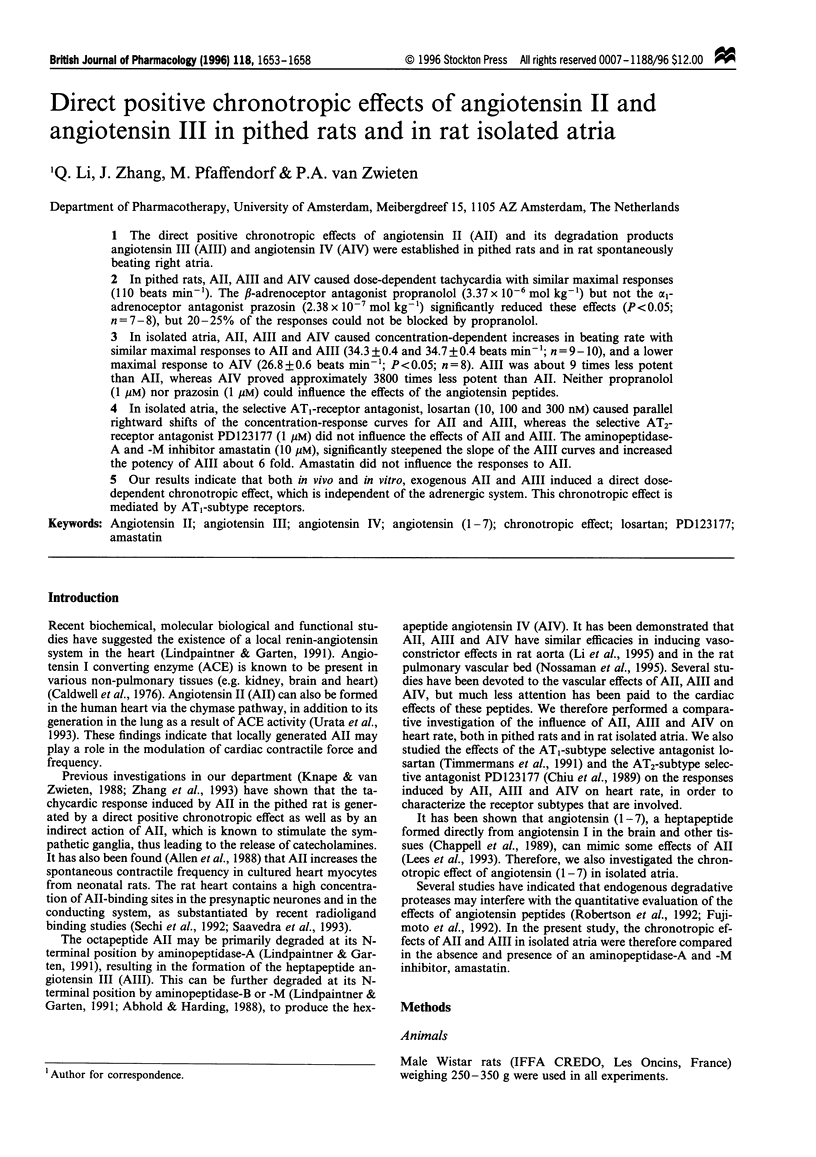
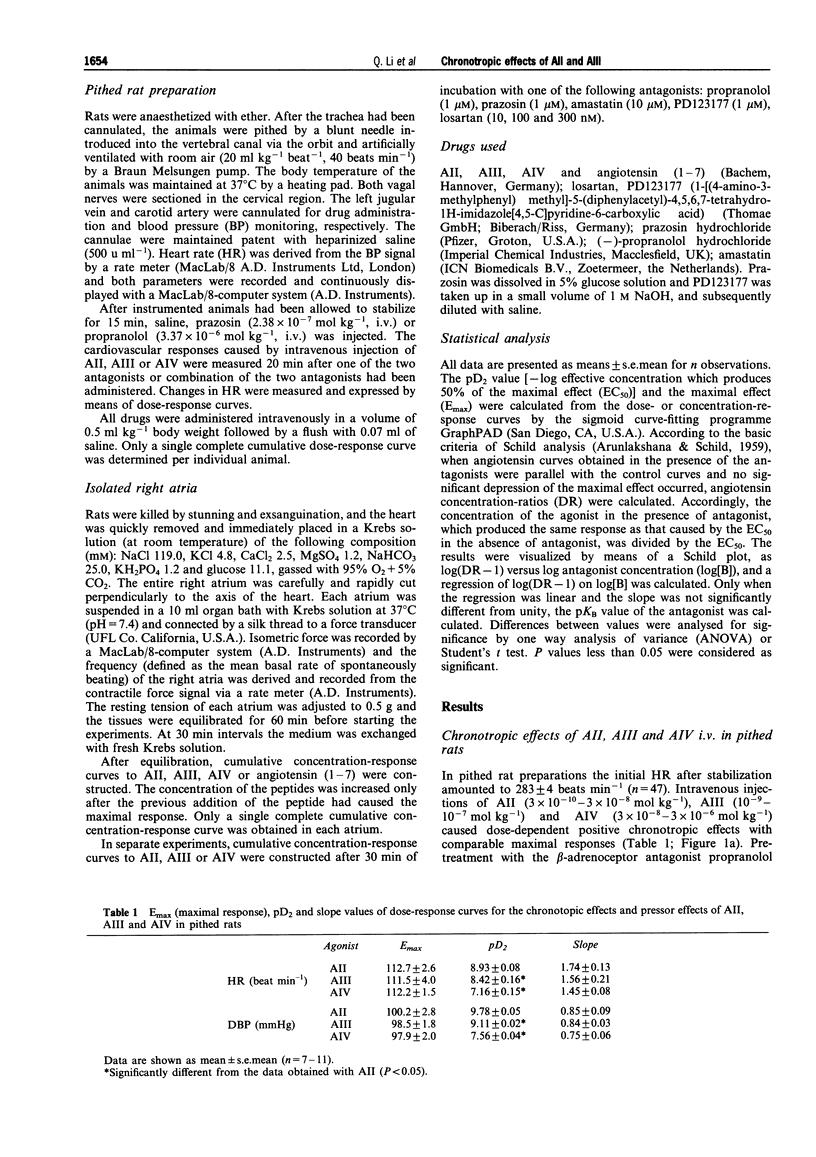
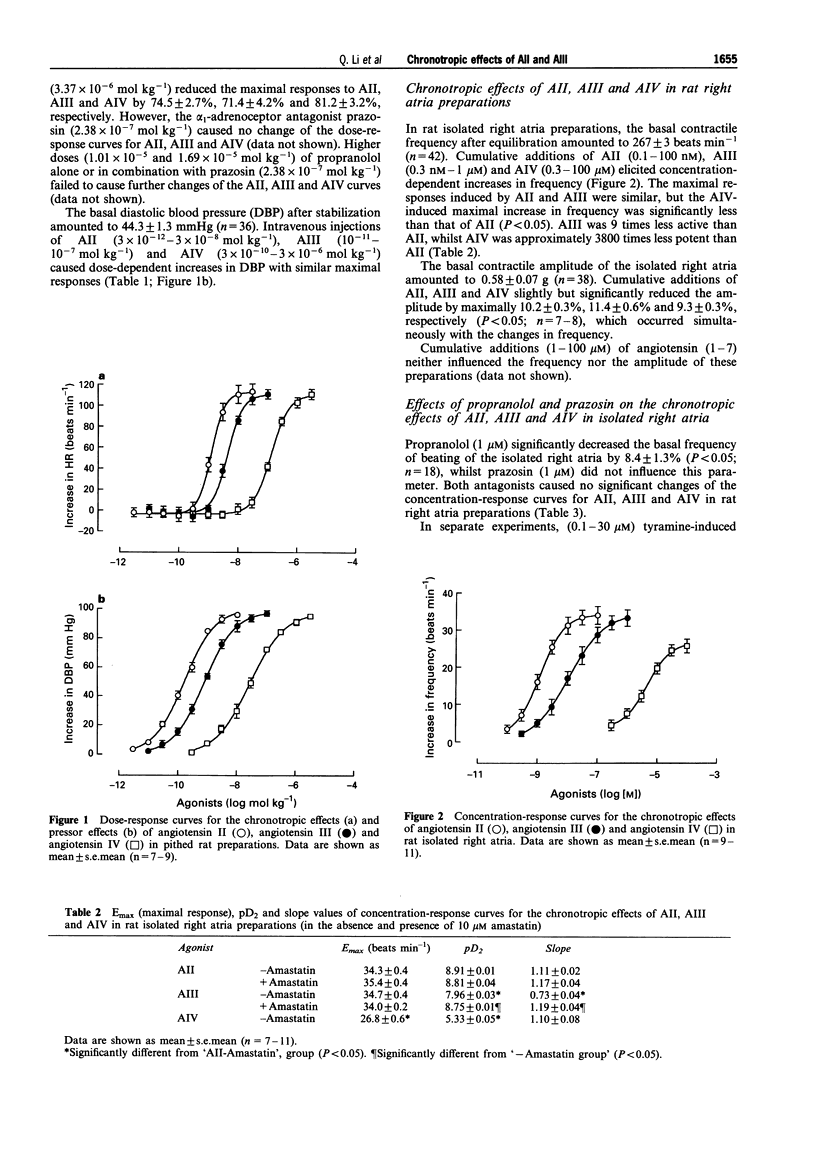
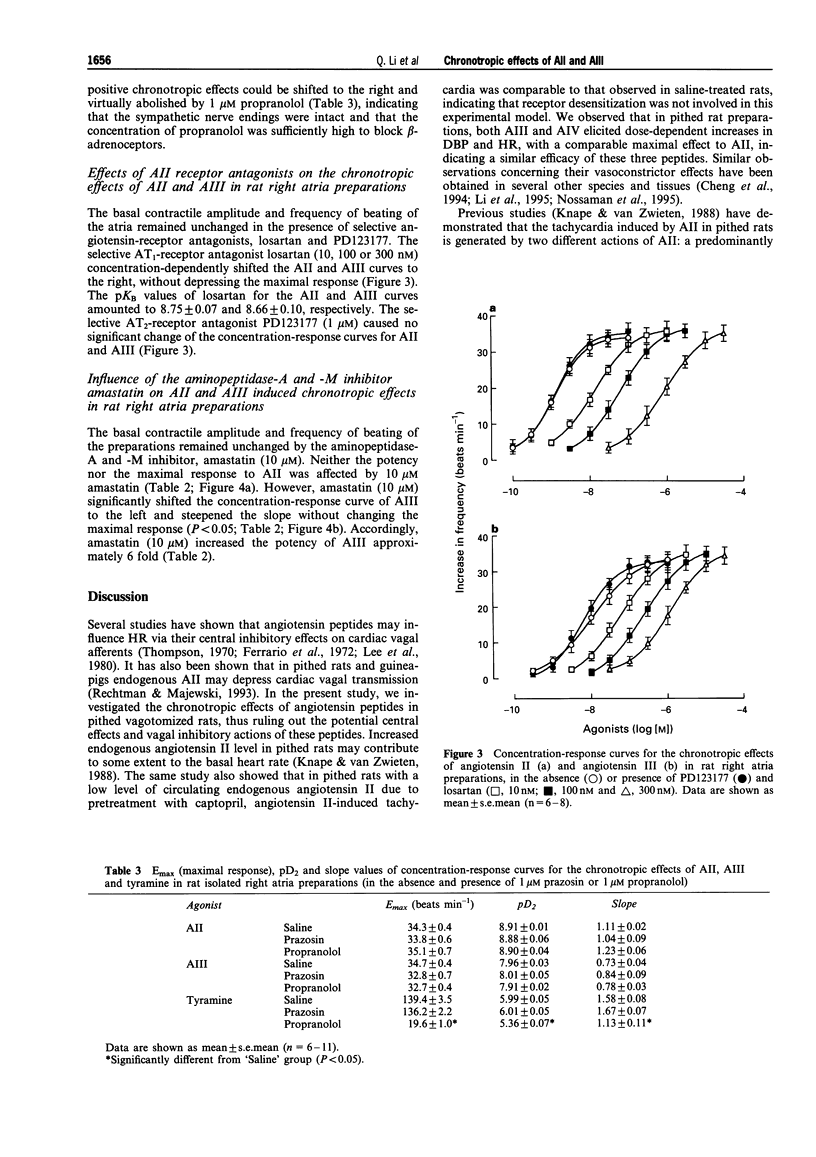
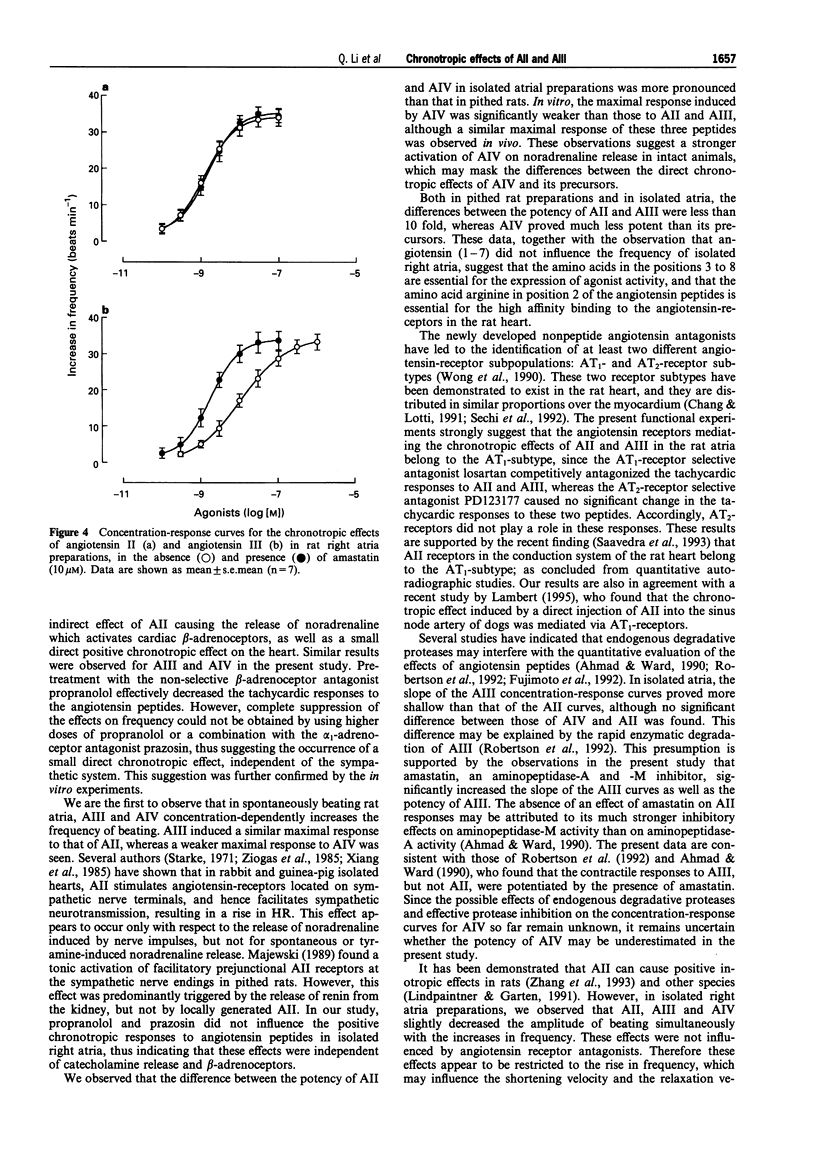
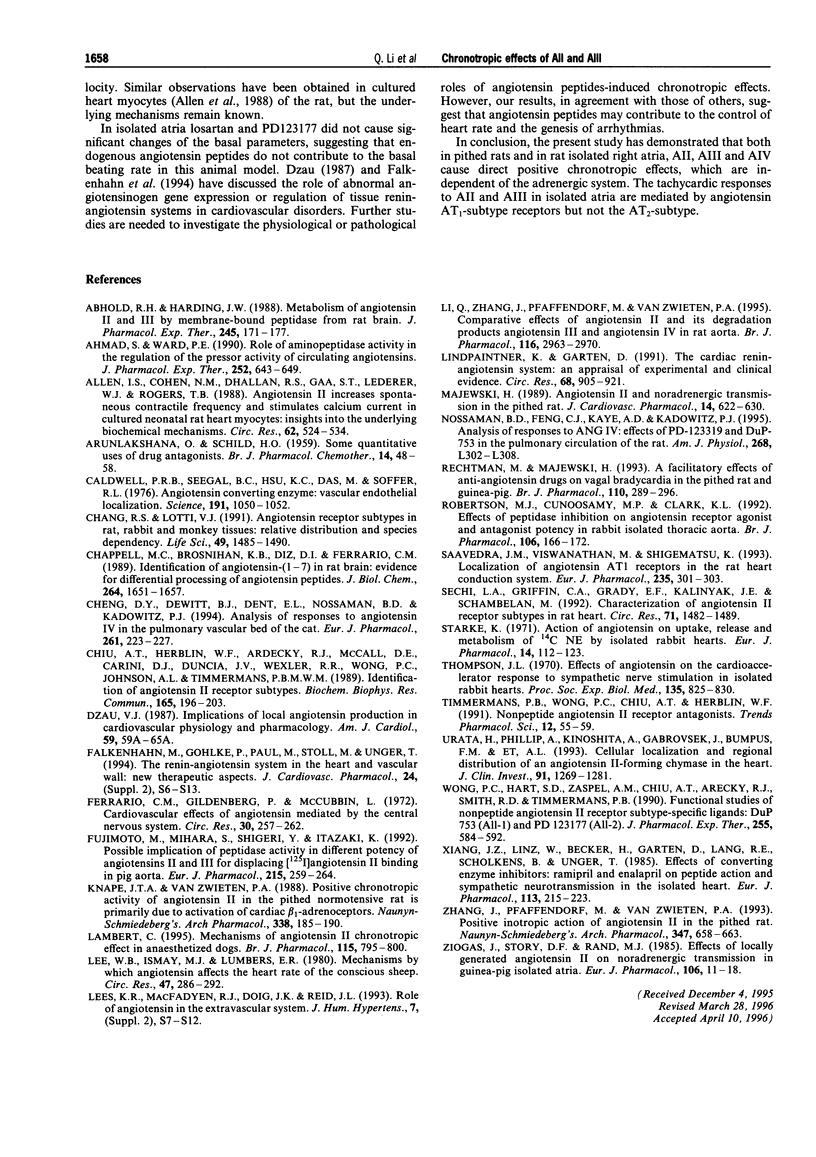
Selected References
These references are in PubMed. This may not be the complete list of references from this article.
- ARUNLAKSHANA O., SCHILD H. O. Some quantitative uses of drug antagonists. Br J Pharmacol Chemother. 1959 Mar;14(1):48–58. doi: 10.1111/j.1476-5381.1959.tb00928.x. [DOI] [PMC free article] [PubMed] [Google Scholar]
- Abhold R. H., Harding J. W. Metabolism of angiotensins II and III by membrane-bound peptidases from rat brain. J Pharmacol Exp Ther. 1988 Apr;245(1):171–177. [PubMed] [Google Scholar]
- Ahmad S., Ward P. E. Role of aminopeptidase activity in the regulation of the pressor activity of circulating angiotensins. J Pharmacol Exp Ther. 1990 Feb;252(2):643–650. [PubMed] [Google Scholar]
- Allen I. S., Cohen N. M., Dhallan R. S., Gaa S. T., Lederer W. J., Rogers T. B. Angiotensin II increases spontaneous contractile frequency and stimulates calcium current in cultured neonatal rat heart myocytes: insights into the underlying biochemical mechanisms. Circ Res. 1988 Mar;62(3):524–534. doi: 10.1161/01.res.62.3.524. [DOI] [PubMed] [Google Scholar]
- Caldwell P. R., Seegal B. C., Hsu K. C., Das M., Soffer R. L. Angiotensin-converting enzyme: vascular endothelial localization. Science. 1976 Mar 12;191(4231):1050–1051. doi: 10.1126/science.175444. [DOI] [PubMed] [Google Scholar]
- Chang R. S., Lotti V. J. Angiotensin receptor subtypes in rat, rabbit and monkey tissues: relative distribution and species dependency. Life Sci. 1991;49(20):1485–1490. doi: 10.1016/0024-3205(91)90048-g. [DOI] [PubMed] [Google Scholar]
- Cheng D. Y., DeWitt B. J., Dent E. L., Nossaman B. D., Kadowitz P. J. Analysis of responses to angiotensin IV in the pulmonary vascular bed of the cat. Eur J Pharmacol. 1994 Aug 11;261(1-2):223–227. doi: 10.1016/0014-2999(94)90324-7. [DOI] [PubMed] [Google Scholar]
- Chiu A. T., Herblin W. F., McCall D. E., Ardecky R. J., Carini D. J., Duncia J. V., Pease L. J., Wong P. C., Wexler R. R., Johnson A. L. Identification of angiotensin II receptor subtypes. Biochem Biophys Res Commun. 1989 Nov 30;165(1):196–203. doi: 10.1016/0006-291x(89)91054-1. [DOI] [PubMed] [Google Scholar]
- Dzau V. J. Implications of local angiotensin production in cardiovascular physiology and pharmacology. Am J Cardiol. 1987 Jan 23;59(2):59A–65A. doi: 10.1016/0002-9149(87)90178-0. [DOI] [PubMed] [Google Scholar]
- Ferrario C. M., Gildenberg P. L., McCubbin J. W. Cardiovascular effects of angiotensin mediated by the central nervous system. Circ Res. 1972 Mar;30(3):257–262. doi: 10.1161/01.res.30.3.257. [DOI] [PubMed] [Google Scholar]
- Fujimoto M., Mihara S., Shigeri Y., Itazaki K. Possible implication of peptidase activity in different potency of angiotensins II and III for displacing [125I]angiotensin II binding in pig aorta. Eur J Pharmacol. 1992 May 14;215(2-3):259–264. doi: 10.1016/0014-2999(92)90036-4. [DOI] [PubMed] [Google Scholar]
- Knape J. T., van Zwieten P. A. Positive chronotropic activity of angiotensin II in the pithed normotensive rat is primarily due to activation of cardiac beta 1-adrenoceptors. Naunyn Schmiedebergs Arch Pharmacol. 1988 Aug;338(2):185–190. doi: 10.1007/BF00174868. [DOI] [PubMed] [Google Scholar]
- Lambert C. Mechanisms of angiotensin II chronotropic effect in anaesthetized dogs. Br J Pharmacol. 1995 Jul;115(5):795–800. doi: 10.1111/j.1476-5381.1995.tb15003.x. [DOI] [PMC free article] [PubMed] [Google Scholar]
- Lee W. B., Ismay M. J., Lumbers E. R. Mechanisms by which angiotensin II affects the heart rate of the conscious sheep. Circ Res. 1980 Aug;47(2):286–292. doi: 10.1161/01.res.47.2.286. [DOI] [PubMed] [Google Scholar]
- Li Q., Zhang L., Pfaffendorf M., van Zwieten P. A. Comparative effects of angiotensin II and its degradation products angiotensin III and angiotensin IV in rat aorta. Br J Pharmacol. 1995 Dec;116(7):2963–2970. doi: 10.1111/j.1476-5381.1995.tb15951.x. [DOI] [PMC free article] [PubMed] [Google Scholar]
- Lindpaintner K., Ganten D. The cardiac renin-angiotensin system. An appraisal of present experimental and clinical evidence. Circ Res. 1991 Apr;68(4):905–921. doi: 10.1161/01.res.68.4.905. [DOI] [PubMed] [Google Scholar]
- Majewski H. Angiotensin II and noradrenergic transmission in the pithed rat. J Cardiovasc Pharmacol. 1989 Oct;14(4):622–630. doi: 10.1097/00005344-198910000-00014. [DOI] [PubMed] [Google Scholar]
- Nossaman B. D., Feng C. J., Kaye A. D., Kadowitz P. J. Analysis of responses to ANG IV: effects of PD-123319 and DuP-753 in the pulmonary circulation of the rat. Am J Physiol. 1995 Feb;268(2 Pt 1):L302–L308. doi: 10.1152/ajplung.1995.268.2.L302. [DOI] [PubMed] [Google Scholar]
- Rechtman M., Majewski H. A facilitatory effect of anti-angiotensin drugs on vagal bradycardia in the pithed rat and guinea-pig. Br J Pharmacol. 1993 Sep;110(1):289–296. doi: 10.1111/j.1476-5381.1993.tb13807.x. [DOI] [PMC free article] [PubMed] [Google Scholar]
- Robertson M. J., Cunoosamy M. P., Clark K. L. Effects of peptidase inhibition on angiotensin receptor agonist and antagonist potency in rabbit isolated thoracic aorta. Br J Pharmacol. 1992 May;106(1):166–172. doi: 10.1111/j.1476-5381.1992.tb14310.x. [DOI] [PMC free article] [PubMed] [Google Scholar]
- Saavedra J. M., Viswanathan M., Shigematsu K. Localization of angiotensin AT1 receptors in the rat heart conduction system. Eur J Pharmacol. 1993 Apr 28;235(2-3):301–303. doi: 10.1016/0014-2999(93)90150-g. [DOI] [PubMed] [Google Scholar]
- Sechi L. A., Griffin C. A., Grady E. F., Kalinyak J. E., Schambelan M. Characterization of angiotensin II receptor subtypes in rat heart. Circ Res. 1992 Dec;71(6):1482–1489. doi: 10.1161/01.res.71.6.1482. [DOI] [PubMed] [Google Scholar]
- Starke K. Action of angiotensin on uptake, release and metabolism of 14C-noradrenaline by isolated rabbit hearts. Eur J Pharmacol. 1971 Apr;14(2):112–123. doi: 10.1016/0014-2999(71)90204-4. [DOI] [PubMed] [Google Scholar]
- Thompson J. L. Effect of angiotensin on the cardioaccelerator response to sympathetic nerve stimulation in isolated rabbit hearts. Proc Soc Exp Biol Med. 1970 Dec;135(3):825–830. doi: 10.3181/00379727-135-35152. [DOI] [PubMed] [Google Scholar]
- Timmermans P. B., Wong P. C., Chiu A. T., Herblin W. F. Nonpeptide angiotensin II receptor antagonists. Trends Pharmacol Sci. 1991 Feb;12(2):55–62. doi: 10.1016/0165-6147(91)90498-h. [DOI] [PubMed] [Google Scholar]
- Urata H., Boehm K. D., Philip A., Kinoshita A., Gabrovsek J., Bumpus F. M., Husain A. Cellular localization and regional distribution of an angiotensin II-forming chymase in the heart. J Clin Invest. 1993 Apr;91(4):1269–1281. doi: 10.1172/JCI116325. [DOI] [PMC free article] [PubMed] [Google Scholar]
- Wong P. C., Hart S. D., Zaspel A. M., Chiu A. T., Ardecky R. J., Smith R. D., Timmermans P. B. Functional studies of nonpeptide angiotensin II receptor subtype-specific ligands: DuP 753 (AII-1) and PD123177 (AII-2). J Pharmacol Exp Ther. 1990 Nov;255(2):584–592. [PubMed] [Google Scholar]
- Xiang J. Z., Linz W., Becker H., Ganten D., Lang R. E., Schölkens B., Unger T. Effects of converting enzyme inhibitors: ramipril and enalapril on peptide action and sympathetic neurotransmission in the isolated heart. Eur J Pharmacol. 1985 Jul 17;113(2):215–223. doi: 10.1016/0014-2999(85)90738-1. [DOI] [PubMed] [Google Scholar]
- Zhang J., Pfaffendorf M., van Zwieten P. A. Positive inotropic action of angiotensin II in the pithed rat. Naunyn Schmiedebergs Arch Pharmacol. 1993 Jun;347(6):658–663. doi: 10.1007/BF00166950. [DOI] [PubMed] [Google Scholar]
- Ziogas J., Story D. F., Rand M. J. Effects of locally generated angiotensin II on noradrenergic transmission in guinea-pig isolated atria. Eur J Pharmacol. 1984 Oct 30;106(1):11–18. doi: 10.1016/0014-2999(84)90672-1. [DOI] [PubMed] [Google Scholar]


